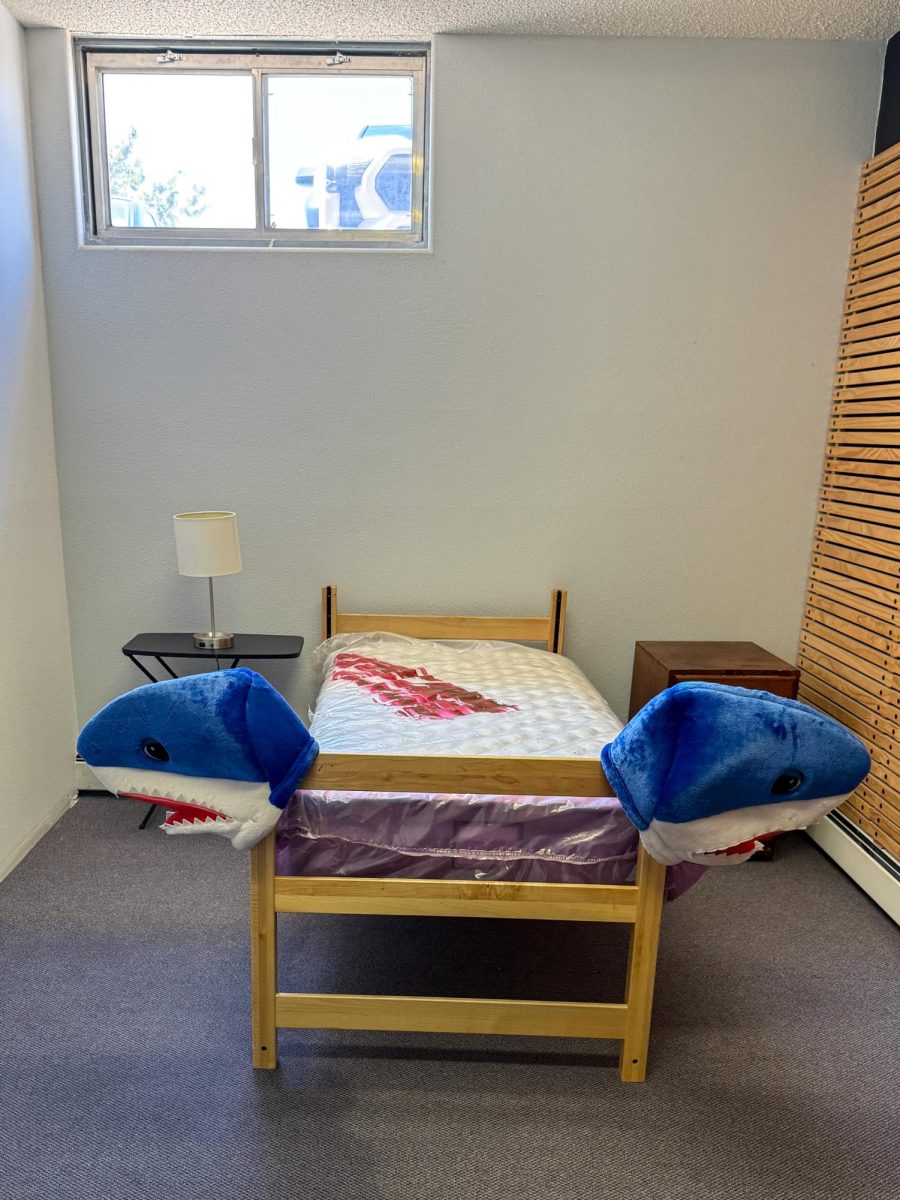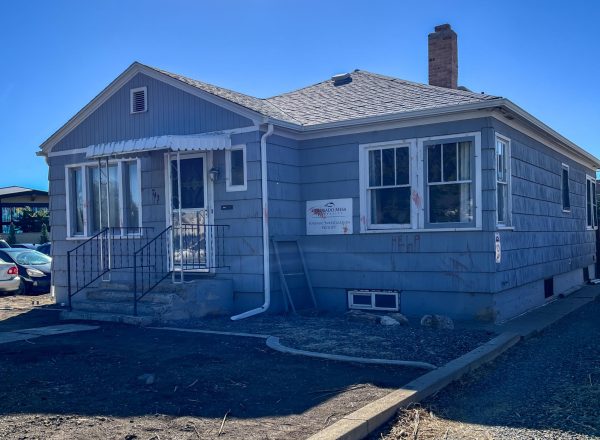
The Crime Scene Lab simulation room is arranged with blood on the mattress of a bed, a bedside table with a lamp and two shark heads that were placed there by Dr. Dante Penington "for fun." The Crime Scene House moved from an off-campus location to three smaller, divided rooms in the Maverick Innovation Center. //Courtesy of the Criminal Justice Department
Over the summer, the criminal justice department’s Crime Scene House officially shut its doors after years in operation. Its bloody history was brought to a violent end by a demolition team, and a new facility will now be located in the Maverick Innovation Center.
Sitting at 743 Texas Ave., the two story house was set up to stage scenes for practice investigations used by the criminal science department’s CRMJ 280 and CRMJ 280L courses. Additionally, the Grand Junction Police Department (GJPD) previously ran practice scenarios in the building.
Following the construction, the previous location is now a dirt lot on its way to becoming a parking lot. CMU pursued this construction project to add more parking options on campus. After the college purchased other homes near the Crime Scene House, other students living there became involved in these ongoing efforts.
This situation has forced residents of neighboring houses to find new places to live over the summer, including mass communication senior Paul Irvine.
“I lived right next door to the crime scene house for three years,” Irvine explained.
He said he sometimes ran into the instructors, and was even involved in a practice fingerprinting for criminal justice students. He also got to witness practice scenarios held by the GJPD in the Crime Scene House, including hostage situations and investigations.
The facility’s nature as a crime scene simulation tool for students also made it the root of many rumors. Irvine was familiar with the rumors, but unsure of their merit.
“The rumor is that Ringo Starr…is the original owner of the forensic house,” said Irvine. “The other rumor is that it was actually one of the original body farms, and that there were three or four bodies buried in the backyard and front yard…to watch the decomposition of the human body.”
When the decision was made to tear down the Crime Scene House, Irvine received a three month notice to find a new place to rent. Some of his neighbors were also required to find alternative housing options.
“As a student, you know, it’s very difficult…if you’re living somewhere through three years, it’s home,” said Irvine. “It was definitely home.”
He now lives near the Community Hospital and commutes to campus.
The loss of the Crime Scene House has also put pressure on criminal justice professors to create a new space where students can get hands-on experience with investigations.

Assistant Professor of criminal justice Dr. Dante Penington has a long history with the house. Despite the recent move, he is dedicated to ensuring students still have a good space for related classes.
“It’s been around for ten years,” said Penington. “Everyone is interested in the ‘crime scene house,’ because it’s a good marketing tool, and that’s what draws a lot of the students. But we don’t have a house anymore.”
Dr. Penington remains optimistic about the new space in the basement of the Maverick Innovation Center. The ‘Crime Scene Lab’ features three rooms for students to explore while taking CRMJ 280 and CRMJ 280L.
In the class, students learn to read blood patterns, process and photograph crime scenes, dust finger prints, read ballistics and determine where shooters are, based on bullet holes.
“This class falls into the forensic investigation minor, and it’s a huge minor with around 200 students,” said Penington. “All sections of the [Crime Scene Lab courses] are full and everyone wants to take it.”
Each section of the Crime Scene Lab’s associated courses is limited to 15 students and they report that it provides a one-on-one experience. However, for students who were looking forward to the Crime Scene House, the new lab is a bit of an adjustment.
“It’s okay,” said junior forensic investigation minor Tyler Brackett. “It’s pretty cramped out here with all the people, but, you know, it gets the job done.”
Previously, the class was set to have four sections taught by three professors. One of the professors resigned last semester and the course offerings switched to three sections.
Two of the three sections are taught by first time instructor of forensic investigation Professor Reshma Satish.
Satish is enthusiastic to work with students in the Crime Scene Lab and provide hands-on experience.
“When I was learning about this in grad school, we didn’t have a facility like this on campus. Our ‘crime scene house’ was a 45-minute drive from campus,” said Satish. “So we went there maybe once a semester. I don’t know what I would be teaching this class if I didn’t have a lab section. You can’t just lecture about this stuff.”
Despite the loss of the Crime Scene House, Satish and Penington are ensuring students will continue to receive high levels of hands-on experience.